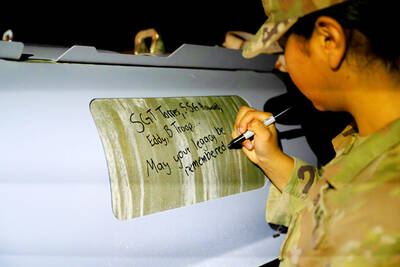From coronavirus-zapping drones to smart masks to disease-predicting wearables, the technology sector is showcasing ways to detect and mitigate the COVID-19 pandemic.
The health crisis which forced this week’s Consumer Electronics Show (CES) online has also spawned innovations for fighting the pandemic.
Drone maker Draganfly showcased its camera technology that can be used to produce alerts on social distancing and also detect changes in people’s vital signs, which might be an early indicator of COVID-19 infection.
Draganfly chief executive Cameron Chell said that the “vital intelligence assessment” system can be “deployed from any camera, not just a drone camera,” to measure vital signs such as heart or respiratory rate and blood pressure.
The company has been deploying its drones to spray disinfectant in large public spaces, such as sports stadiums.
“This allows public places to have the opportunity to be opened up again,” Chell told a CES online briefing. “We’re completely overwhelmed with demand.”
In a similar vein to the Draganfly system, Taiwan-based FaceHeart demonstrated software that can be installed in cameras for contactless measurement of vital signs.
FaceHeart said its algorithms scan for signs of severe shortness of breath, high fever, dehydration, elevated heart rate and other symptoms which are early indicators of COVID-19.
One new wearable device being shown at CES from Colorado-based BioIntelliSense is a coin-sized sticker called BioButton, which can detect changes in vital signs that could be linked to the coronavirus.
The patch, to be worn on a person’s chest, can detect skin temperature, heart rate, coughing frequency and more, the company said.
The BioButton, which is paired with mobile apps, “represents a significant advancement in making continuous medical-grade monitoring reliable, effortless and cost-effective,” BioIntelliSense chief executive James Mault said.
“The convenience of the BioButton will support a range of clinical use cases ... and mass market use to enable safe return to work or school,” Mault said.
Start-up AirPop Health unveiled is Active+ Smart Mask, which captures breathing-related data and incorporates a sensor which can tell wearers when to replace the filter.
“This product embodies the AirPop mission — to help people better understand and take control of their respiratory health, through a human-centered approach to design, science and technology,” AirPop Health founder Chris Hosmer said.
Meanwhile, gaming technology firm Razer showcased its Project Hazel mask.
It features rechargeable ventilators and a transparent design “so those around you can view facial cues, such as a smile or laugh, and allow the hard of hearing to lip read what the wearer is saying,” the company said.
Another gadget unveiled was the Ettie video doorbell from smart home start-up Plott, which takes the temperature of a visitor at the front door with an infrared sensor, allowing the homeowner to see if a fever is present.
Taiwan-based electronics company iWavenology introduced its iDistance wearable device, which can be used to prevent infections by sounding an alarm when people fail to respect social distancing guidelines.
The tags are worn around the arm and function in a workplace or outdoor environment.
“The pandemic requires everyone to think about innovative solutions to ensure safety for all employees at the workplace,” iWavenology founder Mao Shau-gang (毛紹綱) said. “That is why iWavenology created a simple device that generates an alarm whenever a person comes too close to another.”
CES, which was forced to move to an online format because of the pandemic, included about 1,800 exhibitors and concluded on Thursday.

The Burmese junta has said that detained former leader Aung San Suu Kyi is “in good health,” a day after her son said he has received little information about the 80-year-old’s condition and fears she could die without him knowing. In an interview in Tokyo earlier this week, Kim Aris said he had not heard from his mother in years and believes she is being held incommunicado in the capital, Naypyidaw. Aung San Suu Kyi, a Nobel Peace Prize laureate, was detained after a 2021 military coup that ousted her elected civilian government and sparked a civil war. She is serving a

REVENGE: Trump said he had the support of the Syrian government for the strikes, which took place in response to an Islamic State attack on US soldiers last week The US launched large-scale airstrikes on more than 70 targets across Syria, the Pentagon said on Friday, fulfilling US President Donald Trump’s vow to strike back after the killing of two US soldiers. “This is not the beginning of a war — it is a declaration of vengeance,” US Secretary of Defense Pete Hegseth wrote on social media. “Today, we hunted and we killed our enemies. Lots of them. And we will continue.” The US Central Command said that fighter jets, attack helicopters and artillery targeted ISIS infrastructure and weapon sites. “All terrorists who are evil enough to attack Americans are hereby warned

Seven wild Asiatic elephants were killed and a calf was injured when a high-speed passenger train collided with a herd crossing the tracks in India’s northeastern state of Assam early yesterday, local authorities said. The train driver spotted the herd of about 100 elephants and used the emergency brakes, but the train still hit some of the animals, Indian Railways spokesman Kapinjal Kishore Sharma told reporters. Five train coaches and the engine derailed following the impact, but there were no human casualties, Sharma said. Veterinarians carried out autopsies on the dead elephants, which were to be buried later in the day. The accident site

RUSHED: The US pushed for the October deal to be ready for a ceremony with Trump, but sometimes it takes time to create an agreement that can hold, a Thai official said Defense officials from Thailand and Cambodia are to meet tomorrow to discuss the possibility of resuming a ceasefire between the two countries, Thailand’s top diplomat said yesterday, as border fighting entered a third week. A ceasefire agreement in October was rushed to ensure it could be witnessed by US President Donald Trump and lacked sufficient details to ensure the deal to end the armed conflict would hold, Thai Minister of Foreign Affairs Sihasak Phuangketkeow said after an ASEAN foreign ministers’ meeting in Kuala Lumpur. The two countries agreed to hold talks using their General Border Committee, an established bilateral mechanism, with Thailand